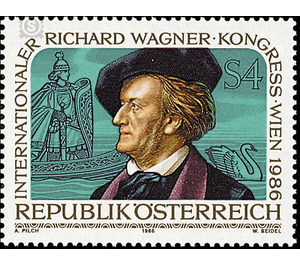congress - Austria / II. Republic of Austria 1986 - 4 Shilling
Theme: Art & Culture
| Country | Austria / II. Republic of Austria |
| Issue Date | 1986 |
| Face Value | 4.00 |
| Color | multi-colored green |
| Printing Type | combination printing |
| Stamp Type | Commemorative |
| Item Type | Stamp |
| Chronological Issue Number | 1192 |
| Chronological Chapter | OOS-OE2 |
| SID | 937998 |
| In 68 Wishlists | |
Richard Wagner was born on May 22, 1813 in Leipzig. Through the contacts of his family to many musicians, artists and scholars of that time Wagner grew up in a culturally demanding environment, which was supplemented by the city of Leipzig with its famous theater, an opera house and the Gewandhaus Orchestra. After elementary school, he attended the University of Leipzig, but soon took private music lessons and became one of the most important composers in history. Among his most famous works are the operas "The Flying Dutchman", "Tannhäuser", "The Ring of the Nibelung", "Lohengrin", "Tristan and Isolde", and "Parsifal". His songs, orchestral works, piano pieces, music theory and other writings document the importance of Wagner. His works are performed at all major opera houses, his music has redirected the entire development in new directions, the influences of his opera dramaturgy are still felt everywhere today. After the successful performance of "Parsifal" Wagner died on February 13, 1883 during a winter holiday in Venice. The Wagner associations, which emerged in and around Germany in the 19th century, had the goal, among other things, of promoting the Bayreuth Festival, founded by Wagner in 1872. One of the oldest of these clubs is the Vienna Richard Wagner Association, which was founded in 1873 as an academic Wagner club. He was also the organizer of this congress. The brand image shows a portrait of Richard Wagner and a scene from the opera "Lohengrin".


